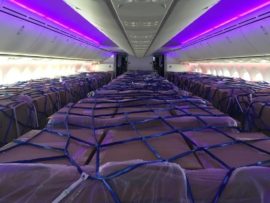The Cargo Services team works with hundreds of freight forwarding professionals around the world. We are working to stay updated on the global freight system to ensure cargo for clients moves as expected. Here’s a summary of what we’re hearing and reading related to the Transpacific region.
Import airfreight
While per kilo pricing from Asia, and particularly China, to the United States remains historically high, rates have dropped out of the double digits. Airlines added all cargo capacity in recent months and volumes are now slipping slightly. The expedited demand for personal protection equipment seems to be waning. When will rates get back to normal? No one knows. International traveler restrictions will have to ease to allow airlines to get back to the business of moving people around the globe.
Ocean imports

One note; express carriers APL and Maston have actually added another vessel in the weekly service from China to LA/Long Beach for their guarantee service, which is at a premium price of course.
State side ports and rail operations are running smoothly with short dwell times at the ports and consistent rail service into inland U.S. rail yards. There is very little congestion at Midwest rail yards and truckers are handling the import volumes effectively.
The outlook
June: Expect it to be mostly the same as in May with high airfreight cost and tight capacity on vessels. And there’s a chance containers will be rolled.
Third quarter: Airfreight rates should continue to ease as demand slows. So far steamship lines have not scheduled any blank sailings for the third quarter. If that remains the case capacity will free up, reducing the chance of containers being rolled, which may bring slight reductions in spot market rates. As states reopen for business, Asian imports will increase, providing confidence to carriers that the second half of the year will be much better than the first.
We’ll keep reading, listening and sharing information as it becomes available.

